It's that time of year, to look back and see what objectives were planned and how effective was I at accomplishing them.
First, I had no plans to start flying again this year. Life was/is still much too hectic for me to engage in another (very expensive time consuming) hobby. So any progress in this area has to be considered a positive. Once I decided to get involved, I had just three objectives: 1) Pass my medical. 2) Pass my Biannual Flight Review for Private Pilot. 3) Fly at least once a week. I planned to start on Instrument Proficiency next year (first half) and perhaps CFI after that.
So, results:
1) I scheduled and passed my 3rd class medical in March. The only restriction is I must wear glasses when I fly.
2) I researched the local area for flight schools. Assessed what I wanted to get out of the training, interviewed some instructors in March and April. I took my first flight in mid-April. I passed the BFR and soloed by the end of May. (Got checked out in a Tiger, then a Warrior, and finally the 'high wing wonder'.)
3) I started flying with 37 weeks left in 2005, I finished the year last night with just over 38 hours. Unfortunately it wasn't every week, but the intent was there.
In addition, I've worked hard on my instrument skills and am getting close to completing the IPC. CFI is still something to consider for next year. (Tailwheel endorsement, Complex a/c)
I underestimated the amount of study required. Books include: Rod Machado's Private Pilot Handbook and Instrument Survival Guide, FAR-AIM, Hayes's Instrument Oral Exam Guide, Eckalbar's IFR: Structured Approach. Various magazines, and of course web sites were all used to get back up to speed. (BTW, I didn't know what a Blog was last year. Podcast?) I also use Microsoft Flight Simulator and the Garmin 430 Simulator.
I also underestimated the 'flight bag'. Headsets (need one for a passenger too), charts, plates, and gadgets like GPS and Transceiver (not needed but definitely nice to have), and other assorted pieces of gear.
So, what about the cost? Roughly twice what I estimated (but then I got further along then initially planned). As my wife said last night "Not a bad investment."
Friday, December 23, 2005
Thursday, December 22, 2005
My Christmas Present
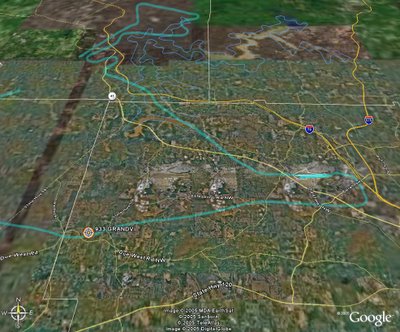
The objectives of this flight: Enjoy.
After all this time, I finally had a chance to fly with Mandy. The weather was great, a bit hazy but ATIS was calling it 10 miles. No clouds and only light winds from the west.
We started the preflight at about 4:30. I carefully explained each step of the procedure, pointing out what I was looking for and why it was important. Same thing once we sat in the cockpit. Gave it some time to sink in, allowed her to ask some questions, and tried to prepare her for what to expect. No surprises. Start, taxi and run up were all normal. Take off was as well, except for her gasps of excitement!
Very smooth air. Climbed to 4500 to get above the haze layer, trimmed it up and let he have the controls. Slow easy turns made easy by the sharp horizontal line caused by the haze. Talked just a little about lift, and why back pressure was needed in a turn. Then I gave some headings to fly, which she did quite well. No problems with airsickness, sinus problems or other distractions. So we flew south for a bit, to enter the pattern from the southwest, hopefully flying over our house. Pretty close, and we did identify our development, but not the house.
The haze mixed with the low light from the setting sun made very poor visibility. Tower was calling traffic within 3 miles that I couldn't see until behind my wing. Navigation lights and beacons just seemed to be a part of the traffic lights below. Entered left traffic number 2 behind a Piper on a right downwind. I was able to pick him up after a few tower calls, and extended the pattern just bit to follow him in.
Checklist complete, on speed, on altitude and the air is smooth as silk. Over the Mall on final, the Piper cleared the runway and it was my turn. Good landing.
"When can we do this again? I mean really?"
Does it get any better then that?
We traveled just 75.4 miles, climbed up to 4627 feet and reached the awesome speed of 135 MPH. What a beautiful night.
C172P
Time = 1.2
Wednesday, December 21, 2005
IFR 10 - IPC (almost)

The objectives of this flight: The Instrument Proficiency Check. I planned the same route as last time, up to Rome, over to Cartersville, and back home. Weather looked good (a little gusty out of the NW, but not bad). Sky as clear as it gets.
However, it was a bit cold, so I got some hands on training on how to use the engine heater. The briefing and preflight were normal. Engine started well (no prime required). Taxi and run up without any problems. Took off to the west and put on the foggles, climbed to 4500.

Radio setup went well. RMG VOR in Nav2, RMG ILS in Nav1, GPS backing up our track to Rome. AMICEATM went fine. We discussed holding entry, and noted on my last flight I entered direct and typically this is a parallel entry. (I pointed out that my heading was 'all over the place due to poor airmanship setting up the GPS, so a direct entry was correct at the time.) Station passage, outbound to the entry, just waiting for the ILS to center. Did not happen, so I used the GPS (which recommended a direct entry) to establish myself outbound. Ahah, ILS still in standby, push the switch and all is ok. (Identify means to actually listen to the dit dah!) ouch

The rest of the approach was fine, down to mins, and could have made the landing. Missed back to the VOR. Nice to have RMG in Nav2 so that I can set up for Cartersville with the GPS. I had selected the Loc like before, but decided to do the VOR A /GPS. This would give me the 'circle to land' approach needed. (Besides I had blown this on IFR 2, so wanted to do it right.) It is an interesting step down approach that takes you right by the cooling towers (1720 ft) at Cartersville. The CFI let me take a peak to underscore the reason for the altitude restrictions. The last step is pretty steep (2200 to 1560 in 1.6 miles). I got to mins, took the foggles off and did a nice circle to land on Rwy 1 (smooth landing).
Cleaned up, climbed out and headed back home. Unfortunately the transponder acted up and we were unable to get vectors for the ILS. We stayed VFR and the CFI provided the vectors needed. More then normal s-corrections, bobbing on GS was not pretty, but not pegged either. (I almost went missed at the Loc mins again.) It was an OK landing.
So, improvement over the last few flights. Airwork is ok, headwork improving. One more flight into a 'strange airport', an "unplanned approach" and maybe some more partial panel work should convince us both that I am ready.
This was a good flight, it should have been great. I know what to do, how to do it, and know when things aren't right, but I'm still not executing to the best of my ability. I'm really looking forward to the next flight.
Focus on the journey, not the destination.
C172p
Time = 1.5
Monday, December 12, 2005
IFR 9 - More Practice

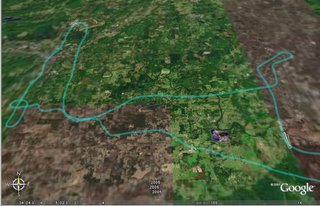
 The objectives of this flight: 1)Build Confidence, 2) Practice procedures.
The objectives of this flight: 1)Build Confidence, 2) Practice procedures.I linked up with a safety pilot for this flight, another private pilot working on his Instrument rating. His job is to look outside for traffic while I wear the foggles and look inside at the instruments.
My plan was to fly VFR direct to the Rome VOR, do the the ILS into Russel (RMG), then right over to Cartersville for the Localizer, then back home and ask for vectors to the ILS at Cobb County.
KRMG 121853Z AUTO 29013G21KT 10SM CLR 13/M01 A2990
KRYY 121845Z 29015G21KT 10SM FEW030 12/M01 A2988
The weather was finally good, although gusting winds to 21 knots would make it interesting. I didn't file a flight plan as most of the work would be around non-controlled fields. The brief, preflight and taxi all went well. It is a little different being in the plane without an instructor, more personal responsibility, less effort to impress. I just felt more comfortable. The safety pilot pointed out things he does a bit different, I shared my procedures, and overall it was a very good 'give and take'. Low voltage light during run-up, avionics off (GPS flight plan lost), master reset, voltage OK.
After we cleared Cobb County airspace I put the foggles on and set up to track inbound to the VOR. Along the way I set up the radios, listened for weather, listened to and advised Rome traffic and generally completed all of AMICEATM. I used the GPS as backup and rediscovered my tendency to apply yoke pressure when fiddling with the GPS. I'm just going to have to put my left hand in my lap when I tune that thing. Otherwise my air work was acceptable, though far from my best.
The ILS uses a holding pattern for the procedure turn, the IAF is defined by the inbound course on the Localizer(Nav 1) and a radial from the RMG VOR (Nav 2). My radio setup was good, and it was nice to have GPS setup as backup and situational awareness. (BTW, approach plates are much easier to read in the daytime.) Gusty winds pushed me around a bit, but I felt very comfortable with the approach. Went to mins and executed the missed back to the VOR.
Since I was tracking with Nav 2, it gave me the opportunity to set up Nav 1 for the next approach. Again, I backed this up with the GPS (careful to scan and not push while tuning in the new procedure). Cartersville had touch and go traffic on the opposing runway, so we stayed at altitude for this one. (Again, I was really interested in procedures, so going down to mins wasn't essential.) Normal procedural turn, intercepted the Loc inbound without any problems, took the foggles off so two sets of eyeballs could look out for traffic. Went missed and told the boys in the pattern I would get out of their way.
Heading east, the setting sun shining on Atlanta was beautiful. City lights were coming on and the traffic jams coming north made me delighted to be in the sky. I contacted approach to see if they could fit me in for vectors to the ILS back home. It must have been a slow night since he gave me a squawk, told me to stay VFR and gave me the vectors I requested. Foggles back on, checklists complete for a beautiful ILS. Foggles off a little above mins, I saw I had maybe 20 degrees crab into the wind so decided to use just 10 degrees of flaps and fly it a little fast. Landing was not my best, but respectable.
Fun! This was a fun flight. I did all of the things I needed to do, found some inherent weakness in my personal routine that can be corrected, and made a new friend at the same time. We traveled 155 miles, got up to 155 mph and climbed all the way up to 3907 feet. (Scattered clouds at 4500 kept us down around 3000 for most of the flight.)

C172p
Time = 1.7
Thursday, December 1, 2005
IFR 8 - Practice, Practice, ...
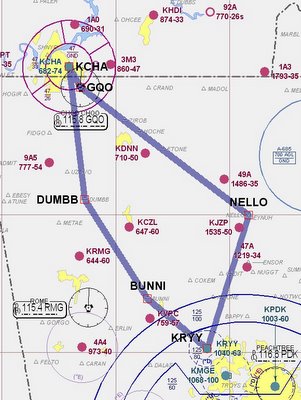
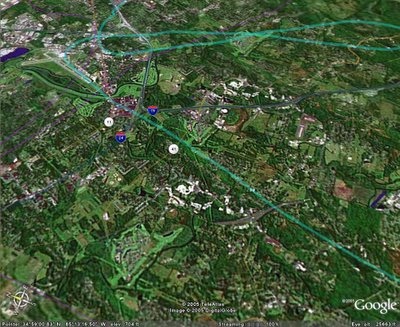
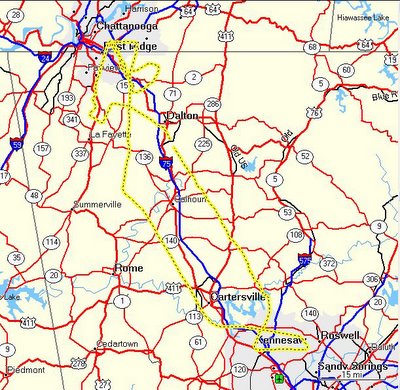 The objectives of this flight: Practice. I filed a flight plan to Chattanooga via airways. I planned to do an ILS followed by VOR/DME arc then back home via standard arrival and a GPS.
The objectives of this flight: Practice. I filed a flight plan to Chattanooga via airways. I planned to do an ILS followed by VOR/DME arc then back home via standard arrival and a GPS.The planning, preflight and takeoff were all normal. We were cleared as filed, which took us to Nello Intersection then V5 into CQO (Choo Choo) for the approaches at KCHA. Two weeks since the last flight, I was a little rusty, or at least not as sharp as I would like. I had to work to track the course, maintain altitude and make the radio calls. The course deviation never got close to pegged, but it was seldom in the donut either.
CHA was pretty busy and I had vectors for spacing before getting on the approach. I was slow to flip the LOC frequency from standby to active and had a difficult time reading the minimums for the approach. (I discovered something here. I've been using a red LED flashlight for my night flying. For whatever reason, when I use that I can't quite focus on the approach plates. Using a standard red flashlight works better for me.) Good course and glideslope, but I missed at the Localizer mins instead of the ILS. (Dummy)
OK, so executed the missed approach and went for the VOR arc. Osily (IAF) is 7 miles out on the 090 radial, and you arc to the south for a 332 final approach course. Winds were quite strong out of the west, so I used a 20 degree cut instead of the normal 10. It worked well. Course control on final was good. Missed there and turned for home.
The air was much smoother on the way home. Basic air work was much better. I asked for and was given the Bunni Two Standard Arrival (STAR), which took us right by RYY. The GPS 27 was good with a nice landing.
Overall it was an OK flight. I was not happy with my air work. It was a good training flight. Nice to go somewhere different, and a great opportunity to review cross country procedures. A little more practice and I should be ready for the IPC.
251 miles round trip, 5047 feet (always just a bit off), and with the tailwind on the way home we got up to 172 mph.
Cessna 172p
Time = 2.6
Friday, November 18, 2005
IFR 7 - Just one of those nights


The objective of this flight: 1) Practice and review. I wanted to get some ground school done, primarily to review Federal Aviation Regulations (FAR Part 91), Aeronautical (Airman's) Information Manual, and Low Altitude Charts and Approach Plates. After that, I wanted to fly a few ILS approaches just for 'polish'. I'm feeling comfortable now, and just wanted to finish off any items prior to the IPC (Instrument Proficiency Check).
The briefing went well. My study of the manuals paid off, and I reviewed the DVD from Sporty's on the IPC. No questions surprised me, and we discussed common sense, practical airmanship as well as what is in the book. (Knowing that you are going into real IMC conditions, what is your minimum equipment list for a Cessna 172?) I missed a lot of questions on the low altitude charts. Everything is on the legend, and I could easily find it there, but probably a good idea not to be searching a legend on the other side of a chart while bouncing around IFR. So, I need to look over that some more.
Question: Is it legal to download approach plates from AOPA or AirNav (or other WWW sources) for use in actual IFR conditions?
We decide to try a PAR into Dobbins AFB. I hadn't done one of those in XX years, so thought it might be fun. Then try some ILS approaches back home and call it a night. KRYY is Notam'd for runway closure at 10:00 PM (local) for repairs, so we need to be back home before then.
So I go out to preflight and it is cold! My planning METAR looked like this, and by 2300Z it was colder:
KRYY 172045Z 34012G18KT 10SM SKC 07/M09
The first really dumb thing; "Normally" I take the key from the dispatch kit and put it on the glare shield. That way it is visible to any maintenance guys, or others walking around the airplane so that they know the twirly thing in the front isn't going to start moving. This time I put it in my jacket pocket. When I removed the pitot cover I put that in the same pocket. Back in the plane, I put the pitot cover in the dispatch kit (so I wouldn't forget about it and take it home with me.) When I got to the START Checklist we spent a good 10 minutes looking for the darn key. It was in the dispatch kit tangled in the flag of the pitot cover.
The rest of the ground procedures were normal. Take off a little squirely due to winds. Contacted Dobbins and found out they don't accept practice PARs for security reasons. OK, I can understand that, but its too bad.
Plan B: My instructor would like to shoot an approach and asks if I would mind being his safety pilot. GREAT! An education in itself watching his setup and execution. It really helps to drive home all of the tips and techniques he taught me, by seeing him using them to such good effect.
After he gets done, its my turn. Foggles on, approach plate ready, time for the ILS 27 at RYY. He asks me to contact ATC and request the approach. This is easy now, and all communications go well. (BTW, it really does help to have an active noise canceling headset.) Radar contact, on vectors for the approach. AMICEATM
Second really dumb thing: The 'C' in the gouge is for Course. I missed it. I checked it on the approach plate but never dialed it into the CDI. So I'm happily plowing along on vectors, "Cessna 361 turn right heading 240 intercept the final approach course you're cleared for the approach". Course deviation for the Localizer is alive, I turn to....the course from the previous approach, 183. CFI says I'm confused. Center says I'm well south of approach course and asks if I need vectors back. The light bulb comes on. "Center, 361, no thank you sir, I can find it." 30+ correction back to course and by this time the Glide slope is coming alive and the course needle is unpegged. "361 remain VFR, switch to tower Frequency." I'm scrambling. Aviate, Navigate, Communicate. Come left to final approach course, power off to start descent, did I miss anything else? Punch the button to bring up Tower. "Tower, Cessna 361 is with you at AKONE (FAF) ILS RWY 27 with information November. 361 Tower, what are your intentions following this approach? 361 will execute a missed approach for another ILS 27. 361 what are your missed approach instructions?" What, is he testing me too? OK, I know this; "Tower 361 will turn right 030 climb to 3000 feet and contact Approach on 121.0" It was not a test, evidently ATC had never made the complete hand off to Tower.
OK, so that one was ugly. CFI asks if I want to try to redeem myself. Redemption is a good thing. Next one goes OK. A little chasing at the end, I think due to winds, but definitely would have been able to land from real IMC.
Humility is a good thing. Just about the time you think you have this stuff wired, you get a 2x4 to the side of your head. Bad flight, GREAT(!) training flight. We covered 146 miles, reached 143 MPH and an altitude of 4448 feet.
Cessna 172P
Time = 1.2
Saturday, November 12, 2005
Autumn Color
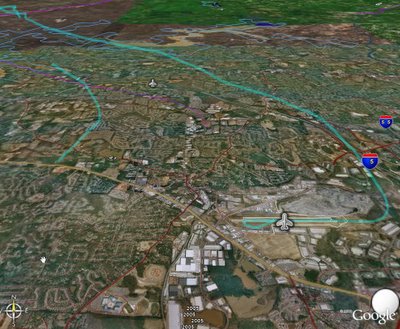 The objective of this flight was very easy: 1) Go north to the Georgia mountains and see the fall colors. N53361 is in for an annual inspection, so I got switched to N737SA, another 172P but without a GPS. It was definitely not required for this flight. Nate called from Cedartown, he had just finished sky diving and wondered if we could pick him up. I was sure that with full tanks, the three of us, and his gear, that the weight and balance numbers wouldn't work.
The objective of this flight was very easy: 1) Go north to the Georgia mountains and see the fall colors. N53361 is in for an annual inspection, so I got switched to N737SA, another 172P but without a GPS. It was definitely not required for this flight. Nate called from Cedartown, he had just finished sky diving and wondered if we could pick him up. I was sure that with full tanks, the three of us, and his gear, that the weight and balance numbers wouldn't work.We were a little late getting to the airport, and as it turned out, the plane needed gas which got us out later then I had wanted. Preflight was normal, but the radio stack was a little different so it took me some time to figure out how to set the frequencies needed for ATIS, ground and tower. The air temperature was a little cooler today, mid 60's, and clear blue sky. Taxi and runup normal, and I decided to let Kathy try a take off. Smooth power, a little rough on the rudder and nice take off attitude. Pretty good for her first attempt. We departed to the north at 2500 feet roughly following I75.
There wasn't as much color as I had hoped for. Maybe because of the low angle of the sun, but the trees were mostly brown and green, not the oranges, reds and yellows I had expected. I let her fly most of the time, no problems encountered. After about twenty minutes she did a 180 and we headed for home. The setting sun illuminated the glass buildings in Atlanta making them seem almost on fire. Entered the pattern on an extended left base and finished with a beautiful landing.
The Flying club was having a Turkey Fry, so we met with Nate for a great dinner. My kind of ambiance, sitting in a hanger watching airplanes land.
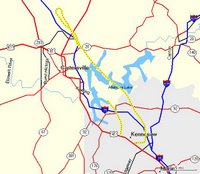
The 96c is working better, but still didn't get a complete track.
C172p
Time = 0.7
Thursday, November 3, 2005
IFR 6 - Communicate
 The objectives of this flight were pretty simple, 1) Work with ATC. This time I checked the winds BEFORE chosing what approaches I would try. The GPS arc at LZU still looked interesting, and an ILS is always fun, and back home I could do a simple GPS.
The objectives of this flight were pretty simple, 1) Work with ATC. This time I checked the winds BEFORE chosing what approaches I would try. The GPS arc at LZU still looked interesting, and an ILS is always fun, and back home I could do a simple GPS.Th flight plan looked like this: Depart KRYY then JOXUV KLZU FLANC KFTY UPHAH then back to KRYY. JOXUV, FLANC and UPHAH are initial approach fixes for what I had chosen.
Brief, preflight, and clearance delivery went fine. The interior lights are still a problem, so we broke out the flashlights again. I was cleared Radar Vectors as filed, climb and maintain 3000. Take off went fine, on with the foggles!
The first approach was the GPS RWY 7 at Briscoe Field (LZU). Radar Vectors means just that, we went well past JOXUV before getting cleared back to it due to heavy traffic. No problem though. What happens when you pass JOXUV and start the arc? Distance will be to the next waypoint, not the center of the arc (in this case PDK). MSG tells you to update course, and if you fly that course it pretty much keeps you on the arc, neat! Not so neat is pushing the OBS instead of the MSG button halfway through, because that suspends the procedure. To correct, go to the Flight Plan page, select the arc and enter. Presto, back on the approach. (BTW, using a flashlight to find little GPS buttons while looking through foggles and bifocals at night is a real trick.) The rest of the approach was routine, missed there and headed toward FLANC.

Well, kinda, because I was still on vectors. It gave me plenty of time to set up for the ILS RWY 8 at Charlie Brown (FTY). I learned something here too. Even though trimmed up nicely, I lost about 150 ft while doing 'A mice ATM' for the next approach. While distracted I had a tendency to gently push on the yoke (positive contact - lesson learned; adjust scan and don't push). The other 'gotcha' is what Linda addressed in her blog. "I have finally resorted to teaching the acronym TITS -- standing for Tune, Identify, Twist (the OBS)and Select the source of input data". I decided to include it under my identify step in 'mice', but the point is, you must know what source is driving the navigation head. I still had it set for GPS and needed to switch it over to VLOC for the ILS approach.

OK, nothing tricky here, just follow the instructions and get vectored around to the final approach course (082). Once headed south the CFII pulled out the instrument covers for partial panel. OK, the key here is to remember timing. Approach vectored us to 140. (180 -140 = 40 or about 15 seconds. Check compass. Pretty close!) "Come left heading 120 intercept final approach course you're cleared for the approach." (140 - 120 = 20 or about 10 seconds. Not bad.) The needles are alive! (120 - 82 = 38 or about 15 seconds. Pause and see what the needle says.) Right of course, turn left count 1, 2, 3 stop turn, wait. Right of course, on glidepath reduce power to 1700 RPM turn left count 1, 2, 3 stop turn, wait. On glidepath and the needle is coming back in for course. Hold wings level wait.....wait...Above glidepath left of course, speed is slow, lower nose back to 90 knots, right turn count 1, 2, 3 wait. On glidepath on course, wait... wait, above glidepath on course, reduce power 100 RPM wait. On speed above glidepath take off another 100 RPM wait. Needle stopped moving but not coming back, another 100 off, right of course, turn left count 1, 2, 3 wings level, wait. Decision height execute missed approach, turn left heading 300 climb to 3000. OK, now what is the math? (Target heading minus Final approach course is 300 - 082 = 140 or about 45 second)...did you start the clock, yep. Nailed it!

Vectors for the GPS RWY 9 back home was uneventful. Took the foggels off at mins, slightly left of centerline. And oh, what a beautiful landing!
Great flight. I was especially pleased with the approach at LZU, since it taught so much about the Garmin 430. I'm getting very comfortable with this now.
The 96c failed to provide a track again. I'll put it on the glare shield next time.
172p
Time = 2.0
Thursday, October 27, 2005
IFR 5 - Arc
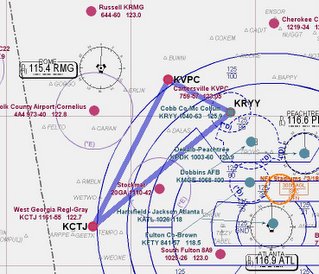 The objectives for the flight were: 1) Communications with ATC, 2) Fly an approach with an Arc, 3) some partial panel work, 4) cross country considerations (IFR enroute).
The objectives for the flight were: 1) Communications with ATC, 2) Fly an approach with an Arc, 3) some partial panel work, 4) cross country considerations (IFR enroute).The plan was to fly down to West Georgia Regional (CTJ) and treat it as a x-country flight. Then up toward the Rome VOR where the CFI would specify an arc to fly to the initial approach fix (IAF) for the Localizer approach into Cartersville (VPC) and end with vectors to the GPS RWY 9 at home (RYY).
There was a new twist tonight. My instructor introduced me to another student and asked if it would be OK for him to come along as an observer. It is common for qualified Private Pilots working on their instrument rating to have a 'Safety Pilot' come along for practice flights. (The two students can split the costs, and don't need to pay for an instructor.) Three 'full sized' men meant that we needed a bigger horse, so I got to fly a different, newer Cessna, C172S - (N2165L). It has a 180 HP engine, fuel injection, and a nice Nav package (but not the Gamin GPS I'm accustomed to using).
The briefing went well and focused on GPS x-country operations. (objective 4) What are the minimum altitudes you should use when going direct from point A to point B? (Not on an airway, is the MEA relevant? What about obstruction clearance? What happens if you have a GPS failure/electrical failure/comm failure while tracking to an unpublished way point?)
Flight down to CTJ was fine, beautiful evening, smooth air, but I had 'foggles' on so didn't see the sunset. (Although I was told it was spectacular.) Shot the full (with procedural turn) ILS RWY 35 without a problem. Airwork is getting solid now, no issues with glide slope control.
Executed the missed there, climbed up to 3500 and headed toward RMG. The CFI asked me to do a 7 mile arc from south to east to intercept the 080 degree radial and fly outbound on it to VPC (kindasorta objective 2). Flying an arc is an interesting exercise (example). You actually break it down into small straight segments, correcting in or out as necessary to maintain the correct distance from the navaid. The trick is to figure out the entry (which way to turn) and then when to make the corrections. I knocked some more rust off my neurons and dove in. These days, its nice to have a GPS that provides a picture (but to be honest, I forgot to use it until I was about half way through the arc.)
Once I intercepted the radial, he placed some instrument covers over the Attitude Gyro and the Directional Gyro. This simulates a vacuum pump failure and is called flying "partial panel"(objective 3). The trick here is making turns. The compass is unreliable while turning, so you are forced to make 'standard rate' turns. (2 minutes to turn 360 degrees.) So, you first calculate how far to turn (080-005= about 90) then figure the number of seconds (about 30) then punch the clock and start the turn. Roll out after 30 seconds, check the compass and correct as necessary.
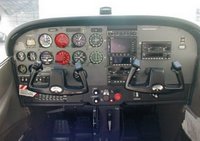 Altitude changes are done by setting the known RPM, flying the right airspeed, and closely checking the VSI and altimeter as always. Needless to say, the pilot is very busy...and yes, if this actually happened in IFR conditions you declare an emergency and get all the help (radar vectors) you can get. Now a big advantage today is (again) GPS. It has actual track over the ground information, and some even have a built in Directional Gyro. No it is not 'cheating' to use this.
Altitude changes are done by setting the known RPM, flying the right airspeed, and closely checking the VSI and altimeter as always. Needless to say, the pilot is very busy...and yes, if this actually happened in IFR conditions you declare an emergency and get all the help (radar vectors) you can get. Now a big advantage today is (again) GPS. It has actual track over the ground information, and some even have a built in Directional Gyro. No it is not 'cheating' to use this.With full instruments back, the GPS RWY 9 back home was uneventful.
Another good work out, no question that I was tired by the end of the flight. I'm satisfied with the progress I'm making and feel that I'm getting close to where I should be. My headwork is getting better. A few more flights should do it.
Unfortunately my poor little 96c was stuck in my flight bag under a pile of stuff and probably couldn't find any satellites. No track this time.
C172S
Time = 1.7
*Congratulations Mandy! Last night was her Off Broadway Debut to an Actors Equity audience for "Tick Tick Boom". While still waiting for official reviews, I'm confident this was just an outstanding performance.
Friday, October 21, 2005
IFR 4 - Say Again?
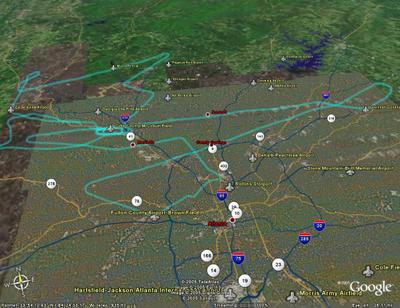 I had four objectives for this flight: 1) I wanted to practice communications with ATC, 2) I needed to refine my air work especially on Glide slope, 3) I wanted to fly an arc approach, and 4) I wanted to file a flight plan.
I had four objectives for this flight: 1) I wanted to practice communications with ATC, 2) I needed to refine my air work especially on Glide slope, 3) I wanted to fly an arc approach, and 4) I wanted to file a flight plan.I planned to fly the ILS RWY 8 at Fulton County (Charlie Brown), the GPS RWY 7 at Gwinnett County (Briscoe Field) and the ILS 27 back into Cobb County (McCollum Field). The relative close proximity meant I would have to work hard to stay ahead of the airplane.
The preflight briefing went well, and since my plan would keep us close to Atlanta, my instructor asked that I file a flight plan (Objective 4). Not a problem. Really just a matter of filing in boxes on a form and calling Flight Service to activate it. (This can be done from the PC these days.)
The preflight was normal. Once started I adjusted the radios so that I was ready for Charlie Brown. I also had to add a step to get a clearance, the reason for the flight plan. It is important to have a pencil ready becasue all instructions must be read back correctly.
Normal Taxi and runup. (Low voltage light had me reset the electrical power, which meant I had to reload the GPS...but no real problem with that.)
After takeoff McCollum tower had me swicth to Atlanta Approach control. One button push on the GPS. They were very busy. It seemd like five minutes before I could break in and identify myself. "Roger Cessna 361 come left heading 120 climb and maintain 4000. State intentions." (Objective 1) No problem, I flew as directed, read back the clearance and asked for the ILS RWY 8 into Fulton County. "Unable 361, State intentions." Brain Freeze.
The instructor helped me out and asked for vectors to VOR A instead. So, some shuffleing to get the right approach and go through my 'gouge'. This is a pneumonic or acronym pilots use to remember stuff:
MICEATM: Marker beacon and align directional gyro to Magnetic compas, identify (the navaide), Course (final approach course), Entry (radar vectors, or as published), altitude(key altitudes for the approach),Time(if needed for the missed approach), Missed approach (procedures). Adding an "A" in front for ATIS (weather and runway information), makes it "A mice ATM".
Airwork was good, really for the entire flight. I need more polish, but flying the airplane is not my problem. Keeping my head in the game is. I must always ask myself what is next, what else can be done, how do I prepare for the next event. I'm not quite back to that way of thinking.
ILS into Briscoe went fine (objective 2), but along the way the airplane instrument lights failed. Time for flashlights. Always have one ready when flying at night.
Missed approach there, radar vectors to ILS back home. No real problems with that one either. Night landing was uneventful.
A GREAT training flight. I learned much, but still have much work to do. I'll find another approach with an arc for next time. (and yes...it really is fun!)
*My thanks to John R (http://johnsflightlog.blogspot.com) for his idea about using Google Earth. Pretty cool! There are three tracks depicted, which represent my flights for October.
Cessna 172p
Time = 1.9
Tuesday, October 18, 2005
Nates 2nd
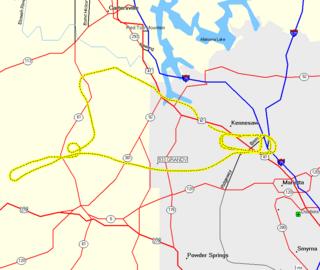 The Flight School had a window from 11:00 to 1:00 for N53361, and the weather is 'severe clear'. Upon arriving I'm told that the vacuum pump is 'squirley', but for my purpose, this is not a problem. (I'll be practicing partial panel later, but with the outstanding weather, the Directional Gyro and Attitude Indicator aren't mission critical.) Normal preflight, taxi and runup. Nate does all of the checklists for me. Position and hold. I explained what to expect and let him take off. Pretty good job, nice rudder control.
The Flight School had a window from 11:00 to 1:00 for N53361, and the weather is 'severe clear'. Upon arriving I'm told that the vacuum pump is 'squirley', but for my purpose, this is not a problem. (I'll be practicing partial panel later, but with the outstanding weather, the Directional Gyro and Attitude Indicator aren't mission critical.) Normal preflight, taxi and runup. Nate does all of the checklists for me. Position and hold. I explained what to expect and let him take off. Pretty good job, nice rudder control.We depart to the west in the general direction of VPC. Talk about airspeed, outside reference and trim. Complete the checklists, etc. We can see to almost forever. Level off at 3,500 feet, and do some basic airwork maneuvers. Turns, climbs, and descents. He does a nice job, very easy on the controls. I think Skydiving has given him "air sense", but I'm not sure if there is a real correlation.
My turn. Back to RYY for some T&Gs. ATIS has changed to Xray, but it is as nice as can be. Light winds right down the runway. Listening for tower calls, looking for traffic and explaining what I'm doing gets a bit hectic, but all works out fine. I abort the first landing (not bad, just not what I wanted) and make two more and a full stop. Nice workout, and I was really glad to have the company. We coverd 89.2 miles, climbed to 4822 feet and had a max speed of 141 mph.
Cessna 172P
Time = 1.2
Wednesday, October 12, 2005
IFR 3 - Aviate, Navigate...
 ...Communicate. I decided to reduce the number of variables and let the instructor do the talking. I just wanted to concentrate on flying...good basic airwork and solid navigation. We planned the GPS RWY 4 at Cherokee County (47A), my first ever GPS approach, followed by the Localizer RWY 19 at Cartersville (VPC) and finished with the VOR/DME RWY 9 at home (RYY).
...Communicate. I decided to reduce the number of variables and let the instructor do the talking. I just wanted to concentrate on flying...good basic airwork and solid navigation. We planned the GPS RWY 4 at Cherokee County (47A), my first ever GPS approach, followed by the Localizer RWY 19 at Cartersville (VPC) and finished with the VOR/DME RWY 9 at home (RYY).The GPS is pretty straight forward, once you get the 'knobology'. Its almost like dialing your cell phone while driving a stick shift in stop and go traffic. Its easier if you have speed dial set up, so I need to learn all of the short cuts to get the Garmin 430 set up quickly. The simulator really helps, and the instructor was able to polish that knowledge a bit more with some good advice. (Direct/enter/enter). My airwork was good. I was able to stay ahead the whole flight without any problems, much better the IFR2.
LOC Rwy 19 was also good. I need to polish my procedures here. Get all of the necessary checklists done (MICEATM), and insure all of the timings are started correctly. I was ahead of the plane, and had not listened to ATIS or CTAF. I need to organize myself better, but overall the approach went well. No longer chasing the needle, instead I put a correction in and wait for effect (about 3 scans) before correcting again. Also, I talk to myself the whole way down stating target heading and next target altitude. That really works. Level off OK, but he suggested I add a bit more pitch up (about one pipper) to really stop the altimeter. Will incorporate that next time.
VOR back home was easy. The approach leaves you way out in 'left field' so it might be dicey in actual conditions, but I had no problems flying it as published. All checklist complete and squeeek on the landing! We covered 95.6 miles in what was a really good confidence builder. Now I need to learn how to talk again.
Time = 1.2
Thursday, October 6, 2005
Weathered Out

I'm learning how to fly in weather, so this should have been the perfect training flight. We decided not to go. Weathered out. I guess it comes down to my personal minimums. I recently saw a DVD with Richard Collins "The Prepared Pilot" (a part of his Air Facts series from Sporty's) and one of the topics focused on things he just would not do. Never overload the airplane, always plan to have at least an hour of fuel remaining after the trip, etc. He also talked about his personal weather minimums. So, what personal rules will I follow?
- IFR, solo, at night: It might happen, but I'm not going to plan on it, and will avoid it if at all possible. Accident statistics support this decision.
- Dick's idea to plan about an hour of gas in the tank sounds pretty good.
- Approach minimus will not be busted, period. (No 'taking a peak'.)
- No re do. If the first approach was flown right, no sense going back again because the weather hasn't changed. Go someplace else (with better weather or lower approach mins).
- No 'circle to land' at a strange field at night.
- Don't continue a flight with things that are inoperative for the sake of making a meeting, job, or family.
- Icing is bad. Always check for icing conditions before the flight. Be prepared to change plans if icing is encountered.
The pictures at the top represent a "no go" situation. The weather at the field (KRYY) is lower then the published minimums (green arrow) for the most likely approach. Too bad, I was really looking forward to flying tonight, but not into the remains of tropical storm Tammy.
Thursday, September 29, 2005
IFR 2 - Chasing it
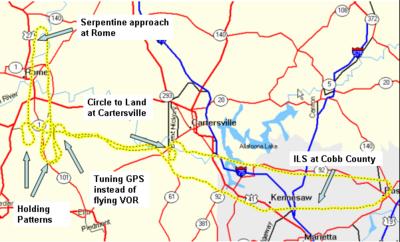
We spent some time briefing this one and decided that the best use of time would be the ILS/DME 1 into Rome (RMG - I-HBQ), followed by a simple VOR/DME A (RMG) into Cartersville and finally an ILS 27 (I-RYY) back home. Pretty straight forward with no apparent tricks, as long as I stayed ahead of the aircraft. I didn't.
The departure was uneventful and the climb to 4500 went fine. I had the 284 from RMG dialed into #2 Nav, Localizer with 007 in Nav #1 with GPS backing up the approach. I chased the needle a little bit inbound, but the rest of my air work was solid. The holding entry to approach was straight forward(right turns - parallel) and I looked good at the initial approach fix (IAF). It went down hill (in more ways then one) from here. I intercepted the glide slope normally, but started chasing the needle for heading. I should have picked a course to fly and let the needle correct, instead I kept chasing it all the way down. Pretty ugly
Missed was fine, back to holding at RMG (left turns - teardrop) , but I was late doing checklist and getting Navaids set up for the VOR into Cartersville. Just plain ugly. Busted mins, chased the needle, overall just worked way too hard. Circle to land went well, and the landing was great.
Picked up radar vectors for the ILS 27 back home. Had to just fly straight for awhile...gave me a chance to think ahead. Everything was set by the time I intercepted the final approach course. I flew course this time, calling out the corrections to myself all the way down. This worked well. Took the glasses off at mins for a beautiful setup for landing. I blew the landing.
Hard, hard workout, but a great training flight. The course covered 165 miles. My cockpit organization is lousy, my procedures are rough, but I'm optimistic. I can do this...and it is REALLY fun!
Time 1.9
Monday, September 26, 2005
Homework

I can remember sitting in a one bedroom apartment, studying a small plastic RMI. Three of us would give different holding instructions while the others tried to figure out the correct entry procedure. Things have changed. Now GPS allows you to see the pattern, provides a direct track to the entry point, and even provides the recommended entry. If only I had been able to have this then. Technology is great. The simulator can be downloaded for free from the Garmin website. Couple this with MS Flight Simulator you can fly the entire lesson while sitting at home with the computer. While the PC doesn’t provide the ‘feel’, it does give you the situational awareness needed to anticipate what the approach should look like.
Thursday, September 22, 2005
First Instrument Flight

After taking off he handed me some "foggles" to put over my glasses so that I could only see the instruments. I continued to climb, turning north to get up to the practice area. I wanted to get the 'numbers' straight. How many engine rpm are necessary to climb at 90kts, what is the pitch up attitude, how many feet per second will that yield? Same for descent, slow flight, etc.
Next I did a Localizer Approach into Cartersville (the straight portion heading south next to route 293), missed approach and did a VOR approach back to Cobb County. I took the glasses off at pattern altitude for the approach, and did a 'circle to land' (left base) to a "squeaker" full stop landing.
It took a little under an hour, but I was so busy it felt like 5 minutes. More approaches (including an ILS) next week.
Total Time = 0.8
Saturday, September 17, 2005
Cessna
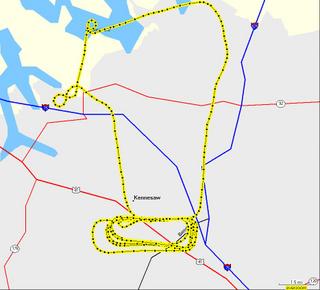
I got checked out in a Cessna 172P last night. I thought you might be
interested in the track. As you can see, we did a number of T&Gs, some
slow flight and steep turns up at the lake, then back (right base) for
some no flap landings. The last was particularly interesting as he
chopped power 700 ft immediately after Take Off and I did a 'tear drop'
back to the opposing runway. A lot of fun.
Time = 1.2
Friday, August 19, 2005
D.R.
 It was time for an exercise. I wanted to navigate the "old way", by planning a flight, drawing lines on a map, and using dead reckoning and visual landmarks on the ground to get from "Point A to Point B". No GPS for this one. I took off solo from KRYY in a Warrior on a Friday morning to avoid the afternoon CBs. First point was Calhoun (CZL), pretty easy as it is just up I75. Next, over to Dalton (DNN), was a little more difficult. Roads are not as prominent as you might think, and there are a lot of tress out there. Even a little haze makes searching the ground difficult, but after a few long minutes the airport was in sight. Finally, the leg home was along a road, keeping the ridge line on my left an looking for the lake. No problem. Entered with a right downwind to a full stop. In can be done...but it sure is nice to have a moving map
It was time for an exercise. I wanted to navigate the "old way", by planning a flight, drawing lines on a map, and using dead reckoning and visual landmarks on the ground to get from "Point A to Point B". No GPS for this one. I took off solo from KRYY in a Warrior on a Friday morning to avoid the afternoon CBs. First point was Calhoun (CZL), pretty easy as it is just up I75. Next, over to Dalton (DNN), was a little more difficult. Roads are not as prominent as you might think, and there are a lot of tress out there. Even a little haze makes searching the ground difficult, but after a few long minutes the airport was in sight. Finally, the leg home was along a road, keeping the ridge line on my left an looking for the lake. No problem. Entered with a right downwind to a full stop. In can be done...but it sure is nice to have a moving mapTime = 1.3
Friday, August 5, 2005
T&Gs
 The weather stinks. The plan was to go out and tour the local area, but visibility is less then 5 miles in haze, so we won't see too much. Kathy decides she wants to come along, and while she has an anti-airsickness device, I'm skeptical. I love to do Touch and Go's. To me they encompass everything in flying; climb, transitions, and landings. But these are not good for someone prone to air sickness. She did great! Four T&Gs in the Warrior plus the full stop. A nice way to spend a summer evening.
The weather stinks. The plan was to go out and tour the local area, but visibility is less then 5 miles in haze, so we won't see too much. Kathy decides she wants to come along, and while she has an anti-airsickness device, I'm skeptical. I love to do Touch and Go's. To me they encompass everything in flying; climb, transitions, and landings. But these are not good for someone prone to air sickness. She did great! Four T&Gs in the Warrior plus the full stop. A nice way to spend a summer evening.Time = 0.5
Saturday, July 9, 2005
Kathy's 2nd
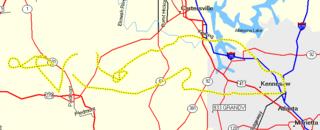
Saturday morning, sunny and dry, with yard work and lots of house work to do. Kathy finally asks;"Can you get the airplane today?" A quick call to the school and I find out that the Warrior is available. Drive over to KRYY and it is really busy. Some Warbirds are in selling rides for a charity. I get the dispatch kit and have her wait in the A/C'd lobby while I do the preflight. I take extra time to brief her on what we will do, what to expect, what things to look for. I also have her read the checklists for me, keeping her involved in the progress of the flight. It is hot!
Taxi checks, run up and take off go fine. Depart to the NW for some simple cruising, and let her fly for a bit. It is going well. Nice easy turns, good horizon, slow climbs and descents. I don't do anything to disturb that inner ear.
Fly over toward Cedartown, where Nate skydives, and listen to CTAF for traffic. No problems, but decide not to risk a T&G, just wander back toward home. All is going real well, she is comfortable, even smiling. Upon contacting the tower I'm told that my traffic is a P51. Can it get better then that? Oh, according to my faded old logbook, her first flight with me was over 31 years ago.
Time = 1.2
Friday, June 17, 2005
Humility

It seemed simple enough. I had been flying a low wing airplane for awhile now, and still liked the round out, transition, and flare that is unique with the wing in ground effect. The weather wasn’t real good, with lots of ‘bumpers’ in the area, so we decided to stay in the pattern and bounce. First one was OK, but the picture wasn’t quite right. Next was left of centerline and fast. It went down hill from there. It just seemed that the airplane was fighting me. I would have a “happy airplane” on base, but turning final things would fall apart. Finally, after numerous attempts, my instructor had pity on the airplane and called it off. Time to try it another day.
Time = 1.2
What happened? A long night flying in my easy chair in front of a silent TV gave me time to replay the flight. First, the pitch was all wrong, because the Tiger is faster and flatter then a Warrior. Second, I was off speed by always coming in too fast. Third, I spotted the deck. I was landing left of CL and in concentrating on that I failed to scan the entire runway prior to the flare.
The first thing I needed to do was go out to the practice area and see a stall. That would help to visualize the correct pitch attitude. Next, I needed to get the basics right. If the approach speed is 74 kts, then don’t fly it at 80 kts. Finally, don’t fixate or ‘spot the deck’. Keep eyes moving all the down the runway.
I got checked out on the next flight without problems…which included a couple of ‘squeakers’.
Time = 1.3
Thursday, June 9, 2005
Nate's 1st

The weather has been lousey. Lots of t-storms, normal for summertime in Georgia. We've been weather'd out twice so far, and I'm not sure about today. I've been unable to get into an airplane for more then a week. Nervous, excited, and iffy weather, is not a good recipe for success. Fortunately I get a Pirep from a returning pilot saying that its pretty good to the south and west, just where I want to go. We can at least take a look. We take off about an hour late (fuel and oil) on 09 with a right hand pattern. I tell the tower that we'll stay in the pattern for T&Gs. The first is high and fast (missed) but the next one good. We depart for Cedartown (KCZL) and the weather turns beautiful! We watch a C5 out of Dobbins circle way out in front of us and we bounce just a bit when we pass through his wake. I make a sloppy entry but a nice T&G. Nate is having fun and I feel great. Straight in back at KRYY to a beautiful landing. Kathy is there to welcome us and take some pictures.
Time = 1.2
Friday, May 27, 2005
Solo

This was it. Nervous but confident. The instructor wanted to see some Lazy 8’s and chandelles out in the practice area. I looked up the definitions on AOPA.com, but was unable to visualize exactly what the pilot should see. Slow flight, stalls, and all the procedures to taxi, T.O, depart and enter a controlled field are all easy now. Not perfect, but I am comfortable and confident. It goes well.
Time = 1.2
The next day is my first solo in nearly 25 years. The weather is fine, no problems with the airplane, and I can’t think of a better way to spend a Friday afternoon. I just want to stay in the pattern for T&Gs. My air work is a little sloppy, but head work is fine. It’s peaceful. This is good stuff, its fun.
Time = 0.6
Sunday, April 10, 2005
What's New
The first entry in my logbook dates back to the late '60s. I flew a Cherokee 140 and built time in an Aeronca Champion. I think both of those planes are probably still flying. The airplanes I'm flying now date back to the early '80s. Not much new there. ATC really hasn't changed much, TCA's are now Class B and Victor airways are still drawn on the charts.
What has changed is what is in the flight bag. When I walked up to the Champ, I didn't even have a flight bag...didn't need one. The biggest improvement is in headsets. I can actually hear the instructor and the tower, and if needed the navaid dit-dah in the background. It is comfortable to carry on a conversation.
Of course its also nice to have the technomagical stuff like a hand held GPS and Transceiver (just in case...), but by far the biggest improvement in the cockpit are headsets.
What has changed is what is in the flight bag. When I walked up to the Champ, I didn't even have a flight bag...didn't need one. The biggest improvement is in headsets. I can actually hear the instructor and the tower, and if needed the navaid dit-dah in the background. It is comfortable to carry on a conversation.
Of course its also nice to have the technomagical stuff like a hand held GPS and Transceiver (just in case...), but by far the biggest improvement in the cockpit are headsets.
Subscribe to:
Posts (Atom)


